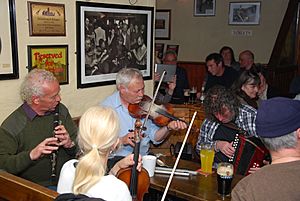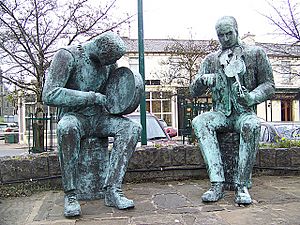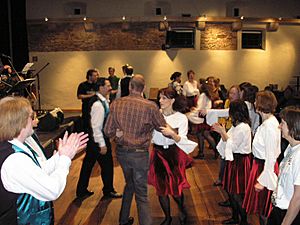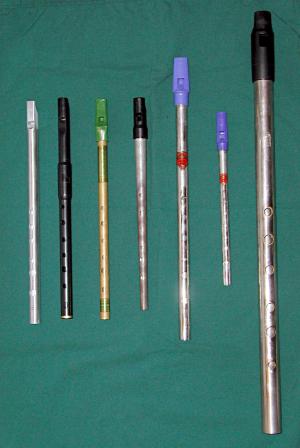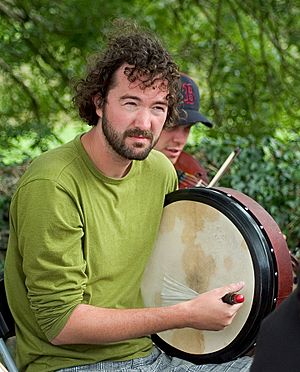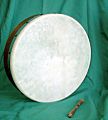Irish traditional music facts for kids
Irish traditional music is a special kind of folk music that grew up in Ireland. People also call it Irish trad or Irish folk music. It's a very old and lively style of music!
Long ago, there were many different instruments used. Some of these included the cruit (a small harp) and clairseach (a bigger harp). There was also the timpan (a string instrument played with a bow or plectrum). Other instruments were the feadan (a fife), the buinne (like an oboe or flute), and the guthbuinne (a bassoon-type horn). People also played hornpipes, bagpipes, trumpets, and bones. The fiddle was even used as far back as the 8th century!
Even though playing alone is common, bands or small groups have likely been part of Irish music for a long time. Irish traditional music has stayed strong even with movies, radio, and TV around. This might be because Ireland wasn't a main battleground in the World Wars. Also, many people worked in farming, where old stories and songs are often passed down by talking.
In the 1970s, Irish traditional music started to influence music in the USA, Australia, and Europe. Sometimes, it even mixed with rock and roll and punk rock!
Contents
How Irish Music Works
Making the Music
Irish dance music is often built from short musical phrases. Think of it like a musical conversation, where one part answers another. A common way tunes are put together is like this: A part, B part, A part, then a small ending. After that, it's A part, B part, A part, and a final ending.
Tunes usually have two main sections, called the A-part and the B-part. Each part is played twice. Then, the whole tune is played three times in a row. So, it goes AABB, AABB, AABB. Many tunes have similar endings for both the A and B parts. While slow songs (called airs) are usually played by themselves, dance tunes are often played in groups. These groups of 2-4 tunes are called sets.
Adding Decorations
Singers and musicians often add special musical decorations to the melodies. These are called ornaments. They use things like grace notes, rolls, cuts, and slides. These make the music sound more interesting and lively.
Playing Together

In Irish music, the main tune is very important. So, the harmony (the chords and background sounds) is usually kept simple or sometimes not there at all. Instruments often play the same melody together. This is called playing in unison. There are no set chord progressions for tunes. Many guitar players use special tunings like DADGAD to help them play along.
Music for Singing
Irish folk music changes slowly over time. Most folk songs are less than 200 years old. The language used in songs can tell us how old they are. Modern Irish songs are sung in English and Irish. The oldest songs often come from the countryside and were originally in the Irish language. Newer songs often come from cities and towns.
Sean-nós Songs
When someone sings alone without any instruments, it's called sean nós. This means "in the old style." Many people think this is the best way to hear traditional singing. Sean-nós singing has lots of musical decorations. A good sean-nós singer will change the melody a little bit in each verse. But they always make sure the words are still clear, because the words are just as important as the tune.
Sometimes, sean-nós singing includes sounds that aren't real words. This is called lilting, and it might sound like "diddly die-dely."
Caoineadh Songs
Caoineadh (pronounced "kwee-nuh") is the Irish word for a lament. These are sad songs that talk about sorrow and pain. Traditionally, Caoineadh songs were about missing Ireland after having to leave because of money problems or politics. They could also be about losing someone you loved. Many Caoineadh songs are connected to difficult times in Northern Ireland. Examples include Far Away in Australia and The Town I Loved So Well.
Long ago, Caoineadh singers were sometimes paid to sing sad songs at funerals.
Dance Music
Irish traditional music and dance happen in many places. These include house parties, country dances, ceili dances, stage shows, and competitions. They are also played at weddings and special holidays. The most common place for Irish dance music is a seisiun. Often, there is no dancing at all at a seisiun!
Types of Dance Tunes
Traditional dance music includes different types of tunes. Some popular ones are reels and hornpipes. There are also jigs, like double jigs and single jigs. Other jigs for dancing include the slip jig and hop jig.
Later, the waltz became popular. In County Donegal, you might also hear mazurkas. Donegal is also known for its "highland," which is a bit like a Scottish tune but feels more like a reel.
Polkas are a type of tune mostly found in the south of Ireland, near Cork and Kerry. Another special rhythm from that area is the Slide.
Playing Styles
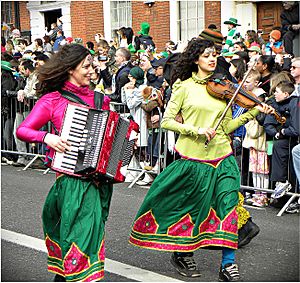
"Style" is very important to Irish traditional musicians. A long time ago, different parts of Ireland had their own unique ways of playing. But with recordings and easier travel, these styles have become more similar. Still, you can hear differences in how musicians from Donegal, Clare, and Sliabh Luachra play. For example, Donegal fiddle players often use fast, energetic bowing. Clare fiddle players use slower bowing and more finger movements to add decorations.
Musicians who play on stage, like groups such as The Bothy Band, have created their own ways of playing. They don't always stick to the old rules of playing for dancers.
Instruments in Irish Traditional Music
The most common instruments in Irish traditional dance music are the fiddle, tin whistle, flute, and Uilleann pipes. These instruments have been around for hundreds of years. Other instruments like the button accordion and concertina became popular later in the 1800s. The 4-string tenor banjo was first used by Irish musicians in the USA in the 1920s and is now fully accepted. The guitar has been used since the 1930s. The bouzouki only joined the traditional Irish music scene in the late 1960s.
The word bodhrán, which is a type of drum, was first mentioned in a document in the 1600s. The saxophone was even heard in recordings from the early 1900s! Bands in the 1940s often had drums, a stand-up bass, and saxophones. Traditional harp playing almost disappeared in the late 1700s. But it was brought back by families like the McPeake Family and musicians like Derek Bell in the mid-1900s. Even though you see harps, they don't play a big part in Irish traditional dance music.
The piano is often used to play background music. In the early 1900s, piano was common on old records. Some piano players today have brought new ideas to how the piano is used in Irish music.
Celtic Rock and More
Celtic rock is a type of folk rock that started in Ireland. It mixes Celtic music and instruments with rock music. This style helped create many famous Celtic bands. A very successful band from this time was Thin Lizzy.
Later in the 20th century, traditional music, especially sean nós singing, became a big part of Irish popular music. Artists like Van Morrison and Sinéad O'Connor used traditional sounds in their songs. Enya became very famous around the world with her mix of New Age and Celtic music. The Pogues, led by Shane MacGowan, mixed Irish folk with punk rock. This led to their songs becoming big hits. In the 1990s, Afro-Celt Sound System combined Celtic instruments with West African music and drum n bass.
In the 1980s, popular folk bands included De Dannan, Altan, and Dervish. More people around the world became interested in Irish music. This helped artists like Mary Black and Sharon Shannon become more well-known. The BBC even made a TV show about how Irish music traveled and influenced music everywhere.
In the 2000s, bands like Beoga, Gráda, Danú, and Teada are some of the newer groups playing mostly traditional music. There are also many other Irish bands that mix local and Irish music, such as Flook and Kíla.
Images for kids
-
Photograph of Patrick Byrne, a harper, from 1845.


